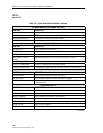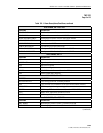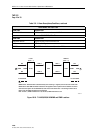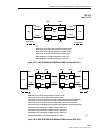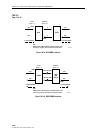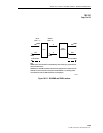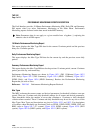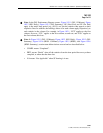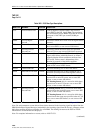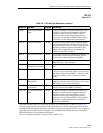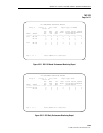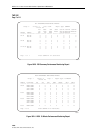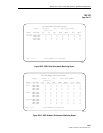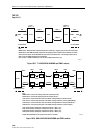
ADCP-61-471 • Issue 4 • June 2000 • Section 2: Operation and Maintenance
2-302
© 2000, ADC Telecommunications, Inc.
TAP-102
Page 3 of 11
Table 102-1. DS1 Mon Type Descriptions
MON TYPE MEANING LOCATION DESCRIPTION
CVL Code Violation Line NEND Count of Bipolar Violations (BPV) and excessive
zeros (EXZ) in the DS1 signal.
Note:
The maximum
rate of indications across HDSL loops that the far end
can report is 166.7 BPV per second (10,000 per
minute).
LOSS Loss Of Signal
Second
NEND A second in which one or more Loss Of Signal defects
occurred.
ESL Errored Second Line NEND A second in which there occurred one or more BPVs,
one or more EXZs, or one or more LOS defects.
SESL Severely Errored
Second Line
NEND A second in which more than some user specified
value of CVLs or one or more LOS defects occurred.
FCP Failure Count Path NEND A count of Loss Of Frame (LOF) or Alarm Indication
Signal (AIS) failures within the interval. A failure is
counted when the failure condition transitions from
OFF to ON. Failure count is independent of the
duration (in seconds) of the failure condition.
CVP Code Violation Path NEND Count of (FE) Frame sync Errors in SF format or
count of CRC errors in ESF format.
AISSP AIS Second Path NEND A second containing one or more AIS defects.
SASP SEF/AIS Second Path NEND A second containing one or more AISSPs or one or
more SEF (Severely Errored Framing/OOF) defects.
ESP Errored Second Path NEND
SF framing format:
this is a second in which there
occurred one or more FE events, one or more SEF
defects, or one or more AIS defects.
ESF framing format:
this is a second in which there
occurred one or more CVP errors, one or more SEF
defects, or one or more AIS defects.
SESP Severely Errored
Second Path
NEND
SF framing format:
this is a second in which there
occurred more than eight FE events, one or more SEF
defects, or one or more AIS defects.
ESF framing format:
this is a second in which there
occurred more than some user specified value of CVP
errors, one or more SEF defects, or one or more AIS
defects.
Note: DS1 Path Parameters are collected at the HLXC for both directions, as shown in Figure 102-7.
Note: Far-end parameters are not derived from defects detected in the incoming signal but rather from the
PRM (Performance Report Messages) embedded in the incoming signal from the far end. A Remote Alarm
Indication condition disallows reception of a valid PRM. The framing format must be ESF for FEND
information to be transmitted and displayed.
Note: For complete information on counts, refer to ANSI T1.231.
(continued)



